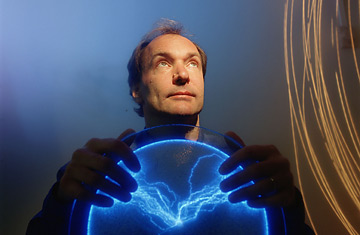home | homework | links | glossary | sitemap | contact
Week 4 - Homework
Tim Berners-Lee
Tim Berners Lee has ensured that all of us are going to be in touch with each other whether we like it or not. He has changed the course of the world when he made the Internet accessible to everyone.
Once he said: "Anyone who has lost track of time when using a computer knows the propensity to dream, the urge to make dreams come true and the tendency to miss lunch."

Sir Timothy (Tim) John Berners-Lee is the inventor of the World Wide Web and head of the World Wide Web Consortium, which oversees its continued development.
He was born June 8, 1955 in London, England. His parents were the quintessential computer geeks. As a matter of fact they met when they were working on the first computer to be commercially sold. It was natural that they encouraged him to think and work innovatively as he grew up. In 1976, Tim Berners-Lee graduated from Oxford University, England, where he’d built his first computer with a soldering iron using a Motorola microprocessor and an old television set.
He worked at Plessey Telecommunications Limited in 1976 as a programmer, and in 1978 he worked at D.G Nash Limited where he worked on typesetting software and an operating system.
In 1980, while an independent contractor at CERN, Berners-Lee proposed a project based on the concept of hypertext, to facilitate sharing and updating information among researchers. With help from Robert Cailliau he built a prototype system named Enquire.
After leaving CERN to work at John Poole's Image Computer Systems Ltd, he returned in 1984 as a fellow. He used similar ideas that he used in Enquire to create the World Wide Web, for which he designed and built the first browser (called WorldWideWeb and developed on NeXTSTEP) and the first web server simply called httpd.
The first web site Berners-Lee built (and therefore the first web site) was at http://info.cern.ch/info.cern.ch and was first put online on August 6, 1991. It provided an explanation about what the World Wide Web was, how one could own a browser, how to set up a web server, and so on. It was also the world's first web directory, since Berners-Lee maintained a list of other web sites apart from his own.
While the component ideas of the World Wide Web are simple, Berners-Lee's insight was to combine them in a way which is still exploring its full potential. But, perhaps his greatest single contribution was to make his idea available freely, with no patent and no royalties due. In 1994 he founded World Wide Web Consortium (W3C) at the MIT Laboratory for Computer Science in Cambridge, Massachusetts, and in 2003, the organization decided that their standards must be based on royalty-free technology, so they can be easily adopted by anyone.
Berners-Lee became the first holder of the 3Com Founders Chair at MIT, and is now a Senior Research Scientist there. He is a Distinguished Fellow of the British Computer Society, an Honorary Fellow of the Institution of Electrical Engineers, a member of the American Academy of Arts and Sciences, and became a Fellow of the Royal Society in 2001. He received the Japan Prize in 2002.
On April 15, 2004 he was named as the first recipient of the Finland's Millennium Technology Prize for inventing the World Wide Web. On July 16, 2004 he was given the rank of Knight Commander Queen Elizabeth II as part of the New Year's Honours. It is the second-highest rank in the Order of the British Empire.